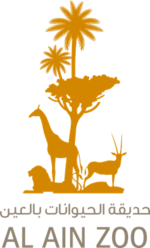Al Ain Zoo
hideThis article has multiple issues. Please help or discuss these issues on the talk page. (Learn how and when to remove these template messages)
|
 | |
 Al Ain zoo entrance | |
| Date opened | April 7, 1968 |
|---|---|
| Location | Al Ain, Eastern Region of the Emirate of Abu Dhabi, the UAE |
| Coordinates | 24°10′33.89″N 55°44′18.57″E / 24.1760806°N 55.7384917°ECoordinates: 24°10′33.89″N 55°44′18.57″E / 24.1760806°N 55.7384917°E |
| Land area | 400 ha (990 acres) |
| Memberships | EAZA[1] WAZA[2] |
| Website | www |
Al Ain Zoo (Arabic: حَدِيْقَة ٱلْحَيْوَانَات بِٱلْعَيْن, romanized: Ḥadīqat Ḥaywānāt Bil-ʿAyn), also "Al Ain Wildlife Park & Resort"[3][4] or simply "Al Ain Wildlife Park" (Arabic: مُتَنَزَّه ٱلْعَيْن لِلْحَيَاة ٱلْبَرِيَّة, romanized: Mutanazzah Al-ʿAyn Lil-Ḥayāt Al-Bariyyah),[5][6][7] is a 400-hectare (990-acre) zoo located in the foothills of Jebel Hafeet in Al Ain, Abu Dhabi, the United Arab Emirates. It is primarily composed of ungulates and herbivores such as Arabian antelopes and oryx, eland, gazelle, lechwe and can be found in the tree shaded paddocks which offer breeding conditions that were deemed 'excellent'.[8] Like the Breeding Centre for Endangered Wildlife in the Emirate of Sharjah, which is now closed to the public,[9] it is a member of the EAZA.[1]
The Al Ain Zoo hosts the rare white lion and Nubian giraffe.[10]
History and fauna[]

The zoo was founded in 1968 by Sheikh Zayed bin Sultan Al Nahyan, the late Ruler of Abu Dhabi and President of the United Arab Emirates, out of concern for the land's wildlife, particularly ungulates such as the Arabian oryx.[2][13]
The zoo features a big cat house. Lions, cougars, jaguars,[4] and black and spotted leopards are found here. In addition to this, it also has a reptile house, monkey compounds, aquarium, and aviary. From February 2010 until July 2010, the Al Ain Zoo hosted the "Dinosaur Trail", a small section which includes around 15 to 20 mechanical dinosaurs with sensors such as Tyrannosaurus rex, as well as information about the dinosaur such as when they lived, which parts of the (current) world they would have been found, and their height and diet, for example.[citation needed]
As of April 2019,[14] the zoo is preparing to expand with work on its perimeters going on at the moment in order to build new sites such as the conservation and breeding centre, African Safari, World Desert Zoo, and the Sheikh Zayed Desert Learning Centre.[5][6]
Gallery[]
Sunset in front of the zoo's entrance

Sand cat, native to the region

Black leopard
Male lion

White lions
Baby macaque
Gazelle with identification tag

Arabian tahr, which is naturally found in Jebel Hafeet and Al Hajar Mountains[15][16][17]
Closeup of Aldabra giant tortoise
See also[]
- Al Hefaiyah Conservation Centre
- Dubai Dolphinarium
- Dubai Safari Park
- Dubai Zoo
- Emirates Park Zoo near Abu Dhabi City
- Sir Bani Yas in the Western Region
References[]
- ^ Jump up to: a b "Where are EAZA members located". EAZA. Retrieved 2019-03-21.
- ^ Jump up to: a b "History". Al Ain Zoo. Retrieved 2019-03-18.
- ^ Forte, Pauline M. (2010-05-22). "Al Ain Wildlife Park: A night at the zoo". Retrieved 2019-04-14.
- ^ Jump up to: a b "Al Ain". The Report Abu Dhabi 2010. Oxford Business Group. 2010. pp. 171–176. ISBN 978-1-9070-6521-7.
- ^ Jump up to: a b Dāwūd, Muḥammad (2010-03-04). "منتزه العين يؤمن حياة كائنات مهددة بالانقراض" (in Arabic). Al-Bayan. Retrieved 2019-04-14.
- ^ Jump up to: a b Sanad, ʿAzzah (2010-04-09). "متنزه العين للحياة البرية بيئة تنبض بالجمال" (in Arabic). Al Ain: Al-Khaleej. Retrieved 2019-04-14.
- ^ "افتتاح متنزه الحياة البرية بحديقة الحيوانات بالعين". WAM (in Arabic). Al-Ittihad. 2017-04-20. Retrieved 2019-04-14.
- ^ Lee, J. "Excellent breeding conditions in Al Ain Zoo, United Arab Emirates". www.planetware.com. Archived from the original on 9 February 2010. Retrieved 2010-02-06.
- ^ "Breeding Centre for Endangered Wildlife". Breeding Centre for Endangered Wildlife. Retrieved 2019-03-21.
- ^ "Al Ain". The Rough Guide to Dubai. Rough Guides UK. 2016-11-01. ISBN 978-0-2412-9864-0.
- ^ Edmonds, J.-A.; Budd, K. J.; Al Midfa, A. & Gross, C. (2006). "Status of the Arabian Leopard in United Arab Emirates" (PDF). Cat News (Special Issue 1): 33–39.
- ^ Spalton, J. A. & Al-Hikmani, H. M. (2006). "The Leopard in the Arabian Peninsula – Distribution and Subspecies Status" (PDF). Cat News (Special Issue 1): 4–8.
- ^ "Overview". Al Ain Zoo. Retrieved 2019-03-18.
- ^ Bridge, Sam (2019-04-13). "Al Ain Zoo plans major projects in tourism push". Arabian Business. Retrieved 2019-04-15.
- ^ WAM (2017-09-13). "EAD raises awareness on Abu Dhabi's natural heritage at ADIHEX 2017". The Gulf Today. Archived from the original on 2018-03-30. Retrieved 2018-03-30.
- ^ De Leon, J. P. (2014-05-26). "100th Arabian tahr, and twin tahrs welcomed in Al Ain". Gulf News. Retrieved 2018-04-03.
- ^ "Newborn Arabian tahr discovered on Jebel Hafeet". The National. 2015-03-12. Retrieved 2018-03-30.
External links[]
 Media related to Al Ain Zoo at Wikimedia Commons
Media related to Al Ain Zoo at Wikimedia Commons- Official website
- Visiting The Al Ain Zoo (in HD) (YouTube)
- AL AIN ZOO - حديقة العين للحيوانات
- حديقة حيوانات العين.. والترفيه الأسري
- منتزه العين للحياة البرية - برنامج وجهات
- 1969 establishments in the Trucial States
- Zoos in the United Arab Emirates
- Tourist attractions in Al Ain
- Buildings and structures in Al Ain
- Zoos established in 1969


























